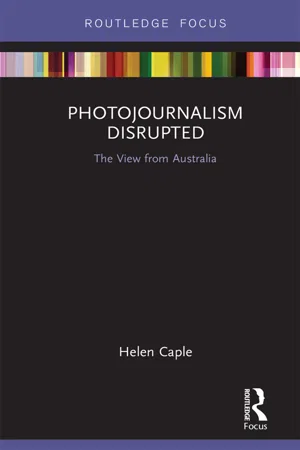
- 110 pages
- English
- ePUB (mobile friendly)
- Available on iOS & Android
About This Book
Photojournalism Disrupted addresses the unprecedented disruptions in photojournalism over the last decade, with a particular focus on the Australian news media context.
Using a mixed methods approach, the book assesses the situation facing press photographers and their employers in the supply of professional imagery for news storytelling. Detailed qualitative case studies looking at special events and crisis reporting complement a longitudinal study of sourcing practices around everyday events. Additionally, interviews with industry professionals offer insights into how news organizations are managing significant structural change. Ultimately, the book argues that photojournalism is being reshaped in line with wider industrial disruptions that have led to the emergence of a highly casualized workforce.
As a comprehensive study of contemporary photojournalism practices, Photojournalism Disrupted is ideal for scholars and students internationally, as well as (photo)journalists and media professionals.
Frequently asked questions
Information
1 Introduction
A decade of disruption
A decade (or more) of disruption for photojournalism
Disruptions of a global scale
Table of contents
- Cover
- Half Title
- Title
- Copyright
- Contents
- List of figures
- List of tables
- Acknowledgements
- 1 Introduction: a decade of disruption
- 2 Investigating visual sourcing practices: data and methodology
- 3 Bearing witness to events of national significance
- 4 Everyday photography: surveying the sourcing of photographs for routine reporting
- 5 The view from the inside: interviews with industry professionals
- 6 Professionals and amateurs: are we all in this together?
- Appendix
- References
- Index